A nurse is collecting data from a client who has Parkinson's disease and is experiencing bradykinesia. Which of the following findings should the nurse expect?
Increased blinking
States of euphoria
Slurred speech
Decreased respiratory rate
The Correct Answer is C
A. Increased blinking
Increased blinking is not a typical manifestation of bradykinesia. In fact, individuals with Parkinson's disease may experience reduced blinking (hypokinesia of blinking) rather than increased blinking.
B. States of euphoria
Euphoria is not typically associated with bradykinesia. Instead, individuals with Parkinson's disease may experience a range of mood changes, including depression, anxiety, or apathy, but euphoria is not a common finding.
C. Slurred speech
This is the correct answer. Slurred speech, or dysarthria, can occur in individuals with Parkinson's disease as a result of bradykinesia affecting the muscles involved in speech production. Bradykinesia can cause a reduction in the speed and coordination of movements necessary for clear speech, resulting in slurred or mumbled speech patterns.
D. Decreased respiratory rate
Decreased respiratory rate is not typically associated with bradykinesia. Bradykinesia primarily affects voluntary movements rather than involuntary processes such as respiration. While respiratory muscle weakness can occur in advanced stages of Parkinson's disease, it is not directly related to bradykinesia.

Nursing Test Bank
Naxlex Comprehensive Predictor Exams
Related Questions
Correct Answer is B
Explanation
A. Excessive salivation:
Excessive salivation is not a common adverse effect of benztropine. Instead, anticholinergic medications like benztropine often cause dry mouth, which is more common than excessive salivation.
B. Difficulty voiding:
Difficulty voiding, or urinary retention, is a potential adverse effect of anticholinergic medications like benztropine. Anticholinergic drugs can cause relaxation of the detrusor muscle in the bladder, leading to urinary retention. Therefore, the nurse should instruct the client to report any difficulty or inability to urinate.
C. Diarrhea:
Diarrhea is not a common adverse effect of benztropine. Instead, anticholinergic medications like benztropine typically cause constipation due to their antimuscarinic effects on the gastrointestinal tract.
D. Slow pulse:
Slow pulse, or bradycardia, is not a common adverse effect of benztropine. Instead, anticholinergic medications like benztropine may cause tachycardia (increased heart rate) due to their effects on the autonomic nervous system.
Correct Answer is D
Explanation
A. Pupil response:
Pupil response refers to the reaction of the pupils to light stimulus. The pupils should normally constrict when exposed to bright light and dilate in dim light. Changes in pupil size or reactivity can indicate alterations in neurological function. For example, unequal or non-reactive pupils (anisocoria or fixed pupils) can be indicative of dysfunction in the cranial nerves or brainstem. However, while pupil response is an important aspect of neurological assessment, it may not always be the earliest indicator of cerebral status changes.
B. Deep tendon reflexes:
Deep tendon reflexes are involuntary muscle contractions in response to stretching of a muscle tendon. These reflexes are assessed by tapping the tendon with a reflex hammer, eliciting a rapid and brief muscle contraction. Changes in deep tendon reflexes can provide information about the integrity of the peripheral nervous system and spinal cord. However, alterations in deep tendon reflexes may occur secondary to changes in cerebral function and are typically assessed along with other neurological signs.
C. Muscle strength:
Muscle strength refers to the force generated by muscles during voluntary movement. It is typically assessed by asking the client to perform specific movements against resistance or by testing the strength of individual muscle groups using standardized scales (e.g., Medical Research Council scale). Changes in muscle strength can occur due to neurological or musculoskeletal conditions. While weakness or paralysis can result from lesions affecting the upper motor neurons (e.g., strokes or spinal cord injuries), alterations in muscle strength may not always be the earliest indicator of cerebral status changes.
D. Level of consciousness:
The level of consciousness refers to the degree of awareness and alertness exhibited by the client. It is assessed by evaluating the client's responsiveness, orientation, and ability to follow commands. Changes in the level of consciousness, such as confusion, lethargy, stupor, or coma, can indicate alterations in cerebral function and are often the earliest indicators of neurological dysfunction. Assessing the level of consciousness is a critical component of neurological examination and helps guide further assessment and management of clients with suspected brain tumors or other neurological conditions.
Whether you are a student looking to ace your exams or a practicing nurse seeking to enhance your expertise , our nursing education contents will empower you with the confidence and competence to make a difference in the lives of patients and become a respected leader in the healthcare field.
Visit Naxlex, invest in your future and unlock endless possibilities with our unparalleled nursing education contents today
Report Wrong Answer on the Current Question
Do you disagree with the answer? If yes, what is your expected answer? Explain.
Kindly be descriptive with the issue you are facing.
